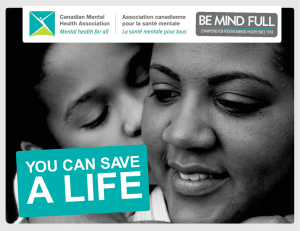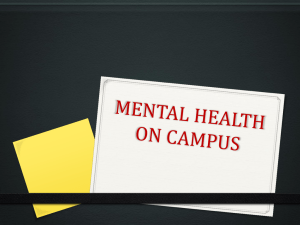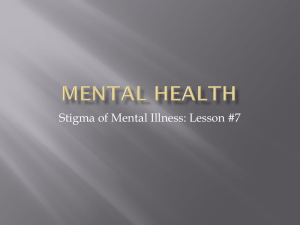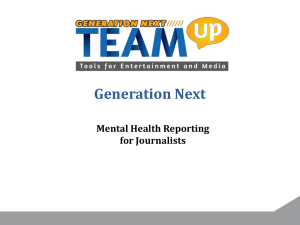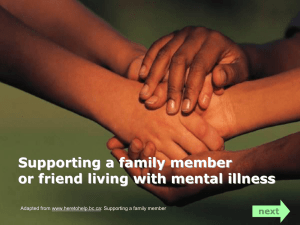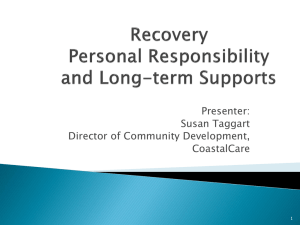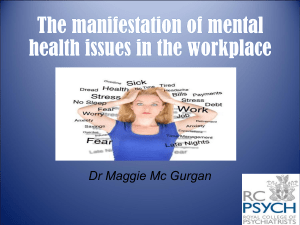Demystifying Mental Health
advertisement
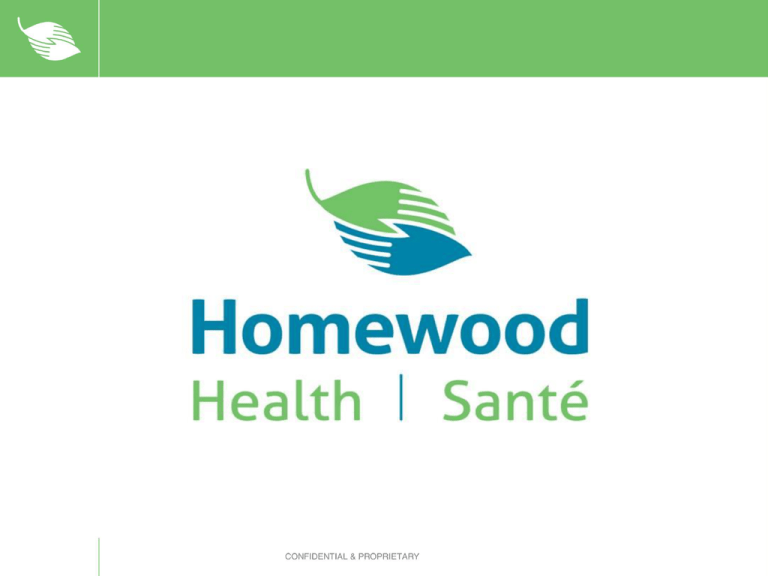
Understanding Mental Illness in the Workplace Presented by: Judith Plotkin, BSW, MSW Date: October 16th, 2013 Objectives • Understand the prevalence and impact of mental illness • Become familiar with stigma associated with mental illness • Learn the facts about mental illness • Identify symptoms of common mental illnesses • Learn strategies to help self and others • Be more confident in approaching an employee at work for whom you have mental health concerns • What can you do at your workplace! Agenda 1. Statistics on prevalence and information on stigma 2. Information on common mental illnesses and treatments 3. Strategies for being a supportive manager 4. Application of mental health strategies to your workplace The cost of mental illness • Mental illnesses are costing Canada about $20.7 billion in 2012 • 28% of workers would be comfortable having a conversation about that worker’s mental health • Stigmas associated with mental health issues, misinformation, fear and prejudice remain prevalent in workplaces Top 10 Medical Conditions (Cost/1000 FTEs) Source: Loeppke, R., et al., . JOEM. 2009;51(4):411-528 Mental illness in the workplace – 51% of employees kept quiet about their mental illness - 43% of Canadians know a colleague with a mental illness - 66% of employees say they do not have the tools at work to help with mental illness -from the 2007 CMHA and Desjardins Financial Security National Mental Health Week Survey - 44% of Canadians have coped with a mental health problem such as extreme stress, depression, substance abuse or schizophrenia -from the Conference Board of Canada study, 2012 Mental Illness 101 Everyone at some point in their life experiences feelings of isolation, loneliness, emotional distress or disconnection… …these are normal, shortterm reactions to difficult situations. In some cases however the duration and intensity may interfere seriously with everyday life. When these conditions persist past a 2 week period, this is when it can turn into a mental illness. The Stigma of Mental Illness • What is Stigma? – a major barrier preventing people from seeking help – negative and unfavorable attitudes – negative behaviours that result from those attitudes • People living with a mental illness often experience stigma through: – Inequality in employment, housing, educational and other opportunities which the rest of us take for granted – Loss of friends and family members (the social and support network) – Self-stigma created when someone with a mental illness believes the negative messages • From the MHCC website, 2012 Signs and symptoms • Understanding the signs and symptoms of mental illness increases awareness • Video clip: – http://gwlcentreformentalhealth.com/wti/Sectio n2Page.aspx Stress and mental/physical health Optimal zone PRODUCTIVITY / JOIE DE VIVRE Boredom Panic STRESS Employee’s Experience Workplace Wellness Programs Can Generate Savings” Health Affairs (2010) Vol. 29:2 and : Drs. Linda Duxbury & Chris Higgins Question? • Why are some people more vulnerable to mental health problems? – Consider: brain function, grief, family issues, work stress, financial problems, substance abuse and addiction, support from social network, etc. Identifying common mental illnesses • General information about symptoms of the four most common mental illnesses in Canada. • Please refer to the resources listed at the end of this presentation for more in-depth information. Symptoms of Depression • Feeling sad, down, hopeless, or worthless • Lack of interest • Fatigue or restlessness • Trouble concentrating & poor memory • Sleep disturbance • Unexplained physical problems • Weight gain or loss • Isolating from others • Anger & irritability • Thoughts of suicide Approximately 9% of adult Canadians will experience a depressive disorder in their life Mood disorder: Bipolar • Alternating high (mania) & low moods (depression) • Poor judgment & risky behavior • Increased physical activity • Inflated self-esteem • Hopelessness & sadness • Loss of energy • Guilt • Suicidal thoughts 1% prevalence rate in Canada Signs of substance abuse • Repeated failure to meet social, occupational or family duties (late or absent, poor performance, neglect of children) • Uncharacteristic mood or personality swings • Spending too much, borrowing or stealing money • Physical signs (agitated or drowsy, blood shot or pinned eyes) • Odor on clothing • Drug paraphernalia Addiction abuse results in one Canadian dying every 32 minutes Anxiety symptoms • Restlessness • Easily distracted • Worry • Feeling on edge • Difficulty concentrating • Poor memory • Irritable or impatient • Sleep disturbance • Unexplained physical problems 12% prevalence rate in Canada Suicide and Risk If you suspect someone may be suicidal: • Be direct and ask • Be open – it does not increase the risk • Be non-judgmental • Take all threats seriously • Look into community resources • Tell someone who can help • Take action if you perceive immediate risk (police, emergency services, hospital) Professional Consultation - If you see signs and symptoms of mental illness, approach the employee and have a discussion. Mention EFAP as a resource to them. - Consider professional consultation if you notice: Changes in mood and/or behaviour that are troubling and persist beyond two weeks What to look out for: - Normally vivacious person is withdrawn - Dramatic changes in appearance - Expressed thoughts of helplessness and worthlessness - Crying without apparent reason - Loss of sleep and/or appetite Supporting someone in need • Listen without rescuing, no “quick fixes” • Offer to find the person support • Don’t judge or blame • Help them remain hopeful • Celebrate success • Share and self disclose • Encourage resilience & self care Strategies for looking after employees • Do… – Familiarize yourself with symptoms of common mental illnesses – Initiate communication with your employee about your concerns – Rehearse beforehand what you are going to say when you approach your employee – Be prepared to face defensiveness, anger, embarrassment by your employee – Inform HR and Management and enlist their support when appropriate (ie, whenever there is a risk involved or when job safety becomes an issue) – Suggest your employee uses the EFAP service – Always put job safety first – LOOK AFTER YOURSELF – be aware of your rights as well as your responsibilities Strategies for looking after coworkers • Do not… – Attempt to make your own diagnoses – Take on the counsellor role – Assume someone else will approach this coworker – Take negative responses personally – often these are symptomatic of the illness itself – Engage in office gossip – Allow your fear of ‘rocking the boat’ to impact on job safety Suggested guideline for approaching a employee you suspect has mental health concerns • Step 1: Choose your time well (i.e., away from others, not late on a Friday afternoon) • Step 2: Begin with open-ended questions – “How are you?” or “How have things been for you lately?” • Step 3: Phrase your concerns with behavior observation language – “I have observed you recently (describe behavior, e.g., forgetting meetings)…” – “On (this occasion) I noticed you (describe behavior, e.g., got mad at Annie for getting paper stuck in the printer)…” Suggested guideline for approaching a employee you suspect has mental health concerns, cont’d… • Step 4: Keep language neutral and supportive – “I enjoy working with you and want to be a supportive employee. I am always here if you would like to talk about things. I will be a safe ear, but your safety and job safety is important to me, so I need to let you know that if anything you say makes me concerned for either of these, I will need to let someone know.” • Step 5: Follow-up with the individual. – “Have you had a chance to think about any of those things we talked over the other day? How are you doing today?” • Step 6: Inform and enlist the support of your supervisor or HR if you feel it is appropriate. Depending on your relationship with the employee, let them know. – “I have still noticed these changes in your behavior and I’m starting to become concerned for your welfare and how our workplace is being affected. I am still here to support you, but I feel in this instance the right thing to do is to involve HR and let them know my concerns.” – YOUR TURN 10 Tips for Mental Health 1. Build Confidence 2. Eat right, Keep fit 3. Make Time for Family and Friends 4. Give and Accept Support 5. Create a Meaningful Budget 6. Volunteer 7. Manage Stress 8. Find Strength in Numbers 9. Identify and Deal with Moods 10.Learn to Be at Peace with Yourself ~from the CMHA website Definition of resilience • The capacity to respond and prosper from stressful circumstances • Ability to bounce back, buoyant • Optimal recovery from stressful events • Being healthy and well despite all of life’s demands Tips on building resilience at work 1. Respect your mental health. – – – – – – Let go of things you can’t control Practice the attitude of gratitude Maintain an optimistic outlook Practice joy through laughter Forgive yourself and others Take breaks during the day 2. Look after your physical health. – Eat nutritiously dense foods – Schedule regular physical activity – Prioritize sleep 3. Create social connections. - Develop a strong supportive network of friends, family and cohorts Tips on building resilience…cont’d 4. Increase your intellectual capacity. - Build skills, knowledge or ability 5. Consider your spiritual health. - Cultivate a positive relationship with yourself first, then cultivate positive relationships with others - Take the time to identify, then live your values – every day - Recognize what you are passionate about - Make it a priority to fit these activities into your life - Restore an inner sense of peace or connection through practicing stress management and relaxation techniques such as meditation, yoga, guided imagery, deep breathing or prayer Tips on building resilience…cont’d 6. At work: - Make every day meaningful - At the end of each day, review your accomplishments then set your priorities for the following day - Make a distinction between work and the rest of your life - Address concerns about deadlines and deliverables early - Minimize the number of times you respond to emails during the day - Take your allotted vacation time - Minimize your connection to work during your vacation time. - Take the time to celebrate successes - Acknowledge your efforts, results and positive impact of these - Be proactive - Don’t ignore issues, recognize it can take time to recover and know that your situation can improve if you actively put energy and attention into it Three Pronged Approach MHCC Road to Psychological Safely Law and science agree that risks to mental health are more likely to arise and contribute to a psychologically unsafe workplace when: Job Demands and Requirements of Effort. Job demands consistently and chronically exceed worker skill levels or exploit them beyond what would be considered reasonable for a particular type of undertaking, or where work is distributed inequitably. MHCC Road to Psychological Safely • Job control or influence. Discretion over the means, manner and methods of their work (including “voice” or the perceived freedom to express views or feelings appropriate to the situation or context) is withheld from workers by choice rather than because of the intrinsic nation of the work. Factors that lead to Healthier Workplaces • • • • • • • • • Transformational Leadership Work Load and Pace Work Schedule Role Clarity Job Future Autonomy Workplace Justice Reduced Status Distinctions Social Environment Call To Action Change the Culture=Change the Outcome – – – – You can start the conversation at work Build peer programs Create executive buy in Talk about mental health and wellness – Wear mental health “lenses” – What is your action plan? In Summary… • Understand: the facts about mental illness • Recognize: the signs and symptoms of mental illness • Act: employ strategies to help yourself and coworkers • Prevention: cost effective and beneficial for employees – how can you be proactive? • Call to Action Break Please be back in 15 minutes Defining addiction • Introduction – – – – Dr. HR Vedelago, MSc., MD, FCFP, ABAM Chief of Addiction Medicine McMaster University Faculty of Family Medicine Director, Addiction Division, Homewood Health Centre, Guelph, ON Dr. Vedelago is a frequent presenter and author of articles and peer-reviewed discussion papers on various aspects of addiction medicine • Addiction – Myths – Misconceptions Resources and information • Mental Health Commission of Canada: http://strategy.mentalhealthcommission.ca • Public Health Agency of Canada: http://www.phac-aspc.gc.ca/ • Alzheimer Society of Canada: www.alzheimer.ca • Check-Up From The Neck Up: http://www.checkupfromtheneckup.ca/ • Mental Health Website: www.mymentalhealth.ca • Canadian Association of Social Workers: www.casw-acts.ca • Canadian Institute for Health Information: www.cihi.ca • Canadian Institutes of Health Research - Institute of Neurosciences, • Centre for Addictions and Mental Health: http://www.camh.net/ • Canadian Medical Association: www.cma.ca • Canadian Mental Health Association: www.cmha.ca Resources and information, cont’d • • • • • • • • • • • Schizophrenia Society of Canada: www.schizophrenia Canadian Psychiatric Association: www.cpa-apc.org Canadian Psychiatric Research Foundation: www.cprf.ca Canadian Psychological Association: www.cpa.ca Centers for Disease Control and Prevention: www.cdc.gov Centre for Addiction and Mental Health: http://www.camh.net/index.html The College of Family Physicians of Canada: www.cfpc.ca Health Canada, Mental Health: http://www.hc-sc.gc.ca/hlvs/mental/index_e.html The Mood Disorders Society of Canada: www.mooddisorderscanada.ca The National Eating Disorder Information Centre: www.nedic.ca National Network for Mental Health: www.nnmh.ca
